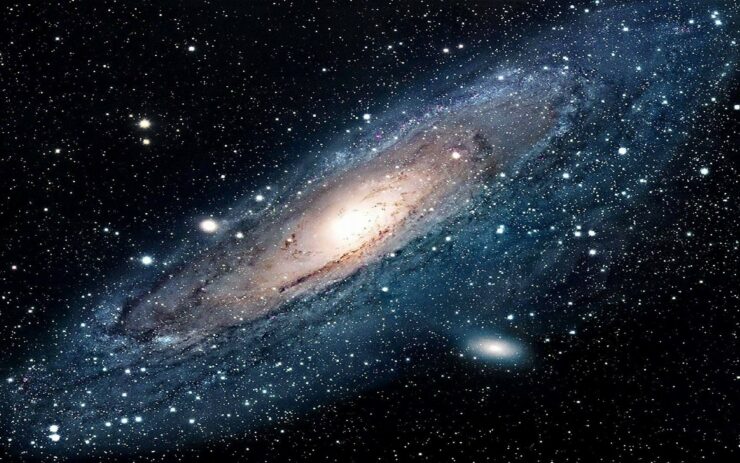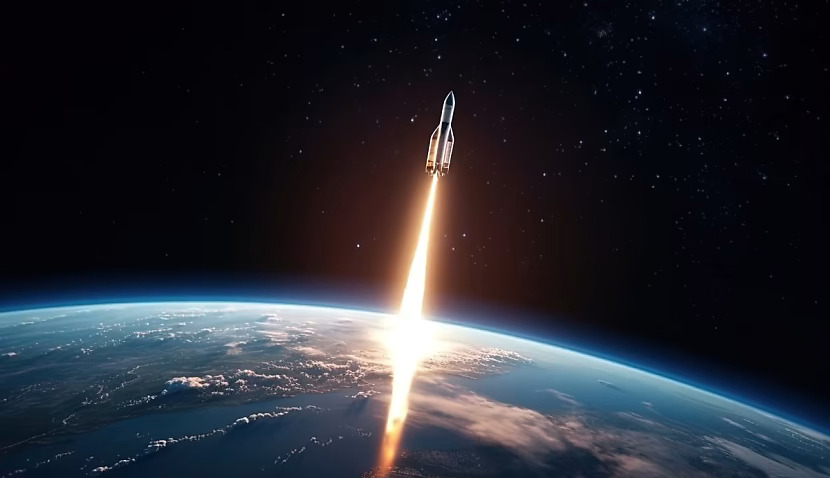Table of Contents
ToggleTop Facts About Space: Unveiling the Amazing Mysteries of the Universe
For millennia, humanity has been captivated by space, the ultimate frontier. The mysteries of the cosmos have always captured the interest of astronomers, both ancient and modern. There are numerous stars, planets, and galaxies dispersed throughout the universe, making the expanse of space virtually unfathomable.
Space is essentially a huge void that exists outside of Earth’s atmosphere. Numerous celestial bodies, including as comets, asteroids, planets, moons, and stars, call it home. It is estimated that the universe is 13.8 billion years old, having originated with the Big Bang, a massive explosion that signaled the beginning of space and time.

This vast cosmic stage is much smaller than our own solar system. It is made up of the Sun, eight planets, their moons, and several additional objects like the Kuiper Belt and dwarf planets. The location of the Earth in the solar system’s habitable zone is essential because it creates the ideal environment for life to flourish.
Astronomy, the study of space, has produced amazing discoveries. While space missions like Voyager have traveled beyond our solar system to provide a view into the extreme reaches of our cosmos, the Hubble Space Telescope has produced breathtaking photos of faraway galaxies. Recent developments in space technology, like SpaceX’s reusable rockets, hold the potential to completely transform space research and travel.
In addition to being a site of scientific interest, space raises important concerns regarding our position in the cosmos. It pushes the boundaries of our comprehension of existence and inspires us to explore the universe for solutions to big questions concerning life and the universe.
Here’s some amazing and lesser-known facts about Space
1. The Immensity of the Universe
The universe has a circumference of over 93 billion light-years, making it incredibly large. This indicates that it would take more than 93 billion years to travel from one end of the observable universe to the other, even if you could travel at the speed of light. The universe is so vast beyond human knowledge that it is constantly expanding, which is even more astounding.
2. The Age of the Universe
It is estimated that the universe is 13.8 billion years old. Studying the cosmic microwave background radiation—the remnants of the Big Bang, which happened about 13.8 billion years ago—allows scientists to calculate this age. It was at this primordial moment when space, time, and everything of our knowledge began.
3. Dark Matter and Dark Energy
It is estimated that dark matter, an enigmatic element that neither emits nor absorbs light, makes up 85% of the matter in the cosmos. Although dark matter cannot be seen with the naked eye, its existence is implied by the way it gravitationally attracts visible matter. Dark energy, which comprises roughly 68% of the cosmos and is assumed to be the cause of the universe’s accelerating expansion, is even more puzzling. Even though dark matter and dark energy are the two fundamental forces in the cosmos, they are still some of the greatest mysteries in contemporary cosmology.
4. Black Holes: The Greatest Mystery in the Universe
Space regions known as black holes are places where gravity is so intense that nothing can escape from them, not even light. At the end of their life cycles, enormous stars collapse under the force of their own gravity, giving rise to them. The point of no return is shown by the event horizon, which is the barrier around a black hole. The standard principles of physics are broken inside a black hole, resulting in singularities where density becomes limitless. Understanding the properties of gravity, space, and time is possible through the study of black holes.
5. The Milky Way Galaxy
The Milky Way, the galaxy where we live, is a barred spiral galaxy with more than 200 billion stars. Its diameter is roughly 100,000 light-years, and its rotation takes about 250 million years. The Milky Way is simply one of billions of galaxies in the cosmos, each with its own distinct structure and history.
6. The Possibility of Extraterrestrial Life
Is there anyone else in the cosmos besides us? is one of the most fascinating questions in space exploration. Finding exoplanets, or planets around stars outside of our solar system, has intensified efforts to find extraterrestrial life. A star’s habitable zone, also referred to as the “Goldilocks zone,” is the area where conditions are ideal for liquid water to exist for life to flourish. Thousands of possible exoplanets have been found by the Kepler Space Telescope; some of them are situated in the habitable zones of their parent stars.
7. The Stars’ Birth and Death
Stars are born in huge clouds of gas and dust called nebulae. When an area within a nebula collapses under gravity, it becomes a protostar, which eventually ignites nuclear fusion in its core, becoming a full-fledged star. Depending on their mass, stars can survive for millions or even billions of years. A star has a spectacular demise when its nuclear fuel runs out, sometimes resulting in a supernova explosion that leaves behind a neutron star, black hole, or white dwarf.

8. UY Scuti, the largest known star
Right now, UY Scuti stands as the biggest star in the cosmos. Situated in the constellation Scutum, this red supergiant star is roughly 9,500 light-years away from Earth. UY Scuti is an absolute giant, with a radius greater than 1,700 times that of the Sun. UY Scuti’s surface would stretch past Jupiter’s orbit if it were positioned at the center of our solar system.
9. Neutron Stars: The Universe’s Densest Objects
The remains of enormous stars that have experienced supernova explosions are known as neutron stars. With a mass similar to that of the Sun yet condensed into a sphere only 20 kilometers in diameter, these stars are extraordinarily compact. On Earth, one teaspoon of neutron star material would be equivalent to almost 6 billion tons. Strong magnetic fields and quick rotation—some neutron stars spin at speeds of hundreds of times per second—are two more characteristics of neutron stars.
10. The Moon: Earth’s Companion
The Moon is the fifth-largest moon in the solar system and the sole natural satellite of Earth. It is essential to maintaining Earth’s axial tilt, which regulates the planet’s seasons and climate. Over billions of years, meteoroids have crashed into the Moon, leaving behind craters all over its surface. The Moon’s geological history and composition were revealed by samples returned from the Moon during the Apollo missions in the 1960s and 1970s.
11. The Hubble Space Telescope: A Window into the Universe
The Hubble Space Telescope, which was launched in 1990, has fundamentally changed our understanding of the cosmos. Hubble, a spacecraft orbiting above Earth’s atmosphere, has taken amazing pictures of far-off galaxies, nebulae, and other celestial objects. Significant findings gleaned from its observations include the acceleration of the universe’s expansion and the existence of supermassive black holes at galaxies’ cores.
12. Olympus Mons, the largest volcano in the solar system
The tallest volcano and highest known mountain in the solar system is Olympus Mons, which is situated on Mars. It is more than twice as tall as Mount Everest, standing at a height of around 22 kilometers (13.6 miles). Olympus Mons is a shield volcano that bears witness to the volcanic activity that once existed on Mars. It is distinguished by its wide, dome-shaped structure.
13. The Kuiper Belt and Oort Cloud
The Kuiper Belt, which includes Pluto and other dwarf planets, is an area full of frozen worlds that extends beyond Neptune. Though more bigger and more substantial than the asteroid belt, the Kuiper Belt is comparable. The Oort Cloud is a putative spherical shell of frozen particles located farther out, at the boundary of the solar system. It is believed that long-period comets that periodically travel to the inner solar system originate from the Oort Cloud.
14. Jupiter’s Great Red Spot
The enormous storm known as Jupiter’s Great Red Spot has been raging for at least 400 years. Larger than Earth, this massive, whirling storm is a noticeable sight in Jupiter’s atmosphere. High-pressure area known as the Great Red Spot is capable of producing winds as high as 432 km/h (268 mi/h). Even though the storm has lasted a long time, it seems to be gradually getting smaller, and scientists are not sure how much longer it will remain.
15. The First Black Hole Image
A momentous first for humanity was the discovery of the first-ever photograph of a black hole in 2019. A picture of the 55 million light-year-distance supermassive black hole in the center of the galaxy M87 was taken by the Event Horizon Telescope, a global network of radio telescopes. Direct visual confirmation of these mysterious objects was provided by the photograph, which showed the shadow of the black hole encircled by a bright ring of hot material descending towards it.
16. The Universe’s Coldest Place
The coldest known location in the universe is the Boomerang Nebula, which is situated in the Centaurus constellation and is 5,000 light-years away. It is colder than the cosmic microwave background radiation that permeates the cosmos, with a temperature of only 1 degree Kelvin (-272.15 degrees Celsius). This newborn planetary nebula was created when a dying star shed its outer layers, exposing a very frigid region.
17. Space is Completely Silent
Nobody can hear you scream in space. This is true because sound cannot travel in a vacuum like space; instead, it needs a medium like air or water. Space is silent because sound waves cannot travel through it in the absence of a medium. In order to communicate with mission control and each other while in space, astronauts use radio communication.
18. The International Space Station (ISS)
An incredible feat of human cooperation and engineering is the International Space Station (ISS). The International Space Station (ISS), which is 400 kilometers (248 miles) above Earth, is used as a platform for scientific study and as a space laboratory. Space agencies from the US (NASA), Canada (CSA), Japan (JAXA), Europe (ESA), and Russia (Roscosmos) are working together on this project. Microgravity experiments carried out by astronauts on the International Space Station (ISS) advance our knowledge of space and the biological sciences.

19. The Loneliness of Voyager 1
Voyager 1, a NASA spacecraft, was launched in 1977 and is the furthest man-made object from Earth. Traveling across interstellar space, it will be more than 14 billion miles (22 billion kilometers) from Earth in 2024. A Golden Record, a time capsule carrying sounds and visuals depicting life on Earth, is carried by Voyager 1. It is anticipated that it will keep traveling across space even after losing communication with Earth.
20. Saturn’s Enigmatic Moon, Titan
The largest moon of Saturn, Titan, is a mysterious realm. Being mostly made of nitrogen, it is the only moon in the solar system with a thick atmosphere. Titan is one of the solar systems most Earth-like worlds, with liquid ethane and methane rivers, lakes, and seas on its surface. Important information about Titan, including its complicated geology and potential for supporting life, was discovered by the Cassini-Huygens mission.
21. The Cosmic Microwave Background Radiation
The entire universe is filled with the cosmic microwave background (CMB) radiation, which is the remnants of the Big Bang. The Cosmic Microwave Background (CMB) was identified in 1965 by Robert Wilson and Arno Penzias. It is a homogeneous, faint glow of microwave radiation that offers an image of the early universe, only 380,000 years after the Big Bang. Scientists have been able to learn about the makeup, structure, and beginnings of the universe through studying the CMB.
22. The Solar Wind and Aurorae
The solar wind is a jet stream of charged particles, mostly protons and electrons, that are expelled from the corona, the Sun’s outermost layer. Aurorae, also known as the Northern and Southern Lights, are breathtaking light displays that are produced when these particles contact with Earth’s magnetic field. Beautiful, vibrant displays of the night sky are produced by aurorae, which are atmospheric gas excitations that occur close to the poles.
23. The Cosmic Speed Limit: The Speed of Light
The fastest speed in the universe is the speed of light, which is roughly 299,792 kilometers per second (186,282 miles per second). Nothing moves faster in a vacuum than light, according to Einstein’s theory of relativity. This cosmic speed limit affects everything from the behavior of particles in accelerators to the possibility of interstellar travel, and it is fundamental to our understanding of space and time.
24. The Search for Exoplanets
Exoplanet discoveries have created new avenues for research into the nature of the cosmos and the possibility of extraterrestrial life. Numerous exoplanets have been detected since the discovery of the first exoplanet in 1992. The size, makeup, and separation of these planets from their parent stars differ greatly. A primary focus of astronomical study remains the hunt for exoplanets, especially those in the habitable zone.
25. The Mystery of Fast Radio Bursts
Intense radio wave bursts that last only a few milliseconds are known as fast radio bursts, or FRBs. FRBs, which were first observed in 2007, are among the universe’s most enigmatic phenomena and come from far-off galaxies. Though their precise cause is still unknown, several ideas link them to black holes, neutron stars, or even extraterrestrial civilizations. Astrophysics’ study of FRBs is a rapidly expanding discipline.
26. The Influence of Gravity on Time
According to Einstein’s general theory of relativity, gravity has an impact on time. Time moves more slowly in larger gravitational fields due to a phenomena called gravitational time dilation. For instance, time moves a little more slowly on Earth’s surface than it does at high altitudes due to a lower gravitational field. Experiments have verified that this effect is necessary for GPS satellites to operate accurately.
27. The Cosmic Web: The Universe’s Large-Scale Structure
The cosmic web is a large-scale structure that exists throughout the universe rather than being evenly distributed. Huge voids divide the massive strands of gas, galaxies, and dark matter that make up this web. The consequence of billions of years of gravitational collapse of matter, the cosmic web stretches hundreds of millions of light-years across. Understanding the genesis and development of galaxies and other large-scale structures in the universe is possible through research on the cosmic web.
28. The Enigmatic Planet Nine
The ninth planet in our solar system, known as Planet Nine, is thought to exist far beyond Neptune. The peculiar orbits of a number of far-off objects in the Kuiper Belt imply the existence of a gigantic, hidden planet, supporting the theory that it exists. If Planet Nine is real, it might have an orbit that takes thousands of years to complete and be up to ten times as massive as Earth. We’re still looking for Planet Nine, and finding it would be a significant step forward in our knowledge of the solar system.
29. The Longevity of the Sun
About 4.6 billion years old, the Sun is the star at the center of our solar system. It is presently in its main sequence phase, during which its core is changing from hydrogen to helium. The Sun has five billion years’ worth of fuel left in it. It will eventually run out of hydrogen and grow into a red giant, engulfing Earth and the other inner planets. The Sun will cool gradually over billions of years to become a white dwarf after losing its outer layers.
30. How Space Exploration Affects Technology
Technological developments spurred by space travel have had a significant influence on our day-to-day existence. Modern society has become reliant on technologies that were created for space missions, including medical imaging, GPS, satellite communication, and weather forecasting. The difficulties faced in space travel continue to push the frontier of creativity, resulting in novel findings and useful applications for humanity.
Conclusion
Space is a place of unending wonder, where inquiry and curiosity are sparked by the universe’s mysteries. Our view of space is always changing, from the size of the cosmos to the complexities of black holes, the hunt for extraterrestrial life, and the technological breakthroughs spurred by space travel.
We are reminded of the infinite possibilities of human inquiry and the amazing voyage of discovery that lies ahead as we gaze up at the sky. The cosmos, in all its mysteries and wonders, is proof of the limitless opportunities that lie beyond the vastness of space.

